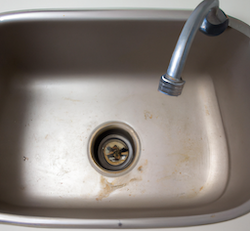How To Unblock A Kitchen Sink Step by Step

Welcome to our handy guide for UK homeowners, renters, and DIY enthusiasts alike, looking to tackle the common issue of a blocked kitchen sink.
Whether it's been caused by food scraps, grease build-up, or a mystery blockage, a clogged sink can be a major inconvenience.
Don't worry though, we're here to help you get things flowing smoothly again.
We'll walk you through a variety of methods on how to unblock a kitchen sink, both with the use of a plunger and without. So roll up your sleeves, and let's dive in!
How To Unblock A Kitchen Sink With A Plunger
Here's a step-by-step guide for our UK audience on how to unblock a kitchen sink using a plunger:
- Prepare the sink and surrounding area.
- Block the overflow for better suction.
- Partially fill the sink.
- Plunge the sink hole with your plunger.
- Check the drain to see if it is working.
Now let's look at each of those steps in more detial:
-
Preparation: First things first, clear out any dishes or debris from your sink. You'll want a clear space to work in.
-
Block the Overflow: Most kitchen sinks have an overflow hole to prevent water from spilling out when the sink is full. When you're plunging, you want to create a vacuum, so use a wet cloth or some duct tape to block this overflow hole.
-
Fill the Sink: Your sink should have some water in it to help the plunger seal, but if it doesn't, add enough to cover the base of the plunger.
-
Plunge Away: Place the cup of the plunger over the drain hole and make sure it's completely covered. Firmly push down on the plunger, then sharply pull up, and repeat. This action can help dislodge whatever is causing the blockage.
-
Check the Drain: After a few good plunges, remove the plunger and see if the water drains away. If it does, congratulations, you've successfully unblocked your sink! If not, it's time to repeat the plunging process.
Remember, unblocking a sink can take a bit of effort and patience, so don't be discouraged if it doesn't work immediately.
However, if after several attempts the blockage persists, you might need to consider other methods or call in a professional plumber.
(Click here to view our kitchen sinks range).
How To Unblock A Kitchen Sink Without A Plunger
Here's a simple guide for our UK audience on how to unblock a kitchen sink without the use of a plunger:
-
Preparation: Start by removing any dishes or debris from your sink. This gives you a clear area to work with.
-
Boiling Water: One of the easiest methods to try first is pouring boiling water down the drain. Boil a kettle full of water, then slowly pour it down the drain. The heat can help to dissolve or dislodge the blockage. Be careful not to pour it all at once and avoid this method if you have PVC pipes, as the heat can loosen their joints.
-
Baking Soda and Vinegar: If the boiling water doesn't work, you can try using a mixture of baking soda and vinegar, two items you likely have in your kitchen already. Pour half a cup of baking soda down the drain, followed by half a cup of vinegar. Wait 15-20 minutes for the mixture to work on the blockage, and then rinse with boiling water.
-
Wire Hanger: Another method is to straighten a wire coat hanger and use it to fish out the blockage. Push it down the drain, twist it around a few times, and try to pull the blockage out.
-
Wet Vacuum: If you have a wet and dry vacuum, it can be a very effective tool to unblock a kitchen sink. You'll need to create a seal for the hose to effectively suction the blockage, which can be done with an old plunger head or by creating one out of a plastic bottle.
-
Chemical Drain Unblocker: Buy a professional grade chemical drain unblocker and pour it down the drain. Follow the instructions very carefully and make sure you wear the safety equipment as advised.
Remember, if the blockage remains after trying these methods, it may be time to call a professional plumber to avoid damaging your pipes.
Click here to see our complete range of 1810 sinks...
Why Do Kitchen Sinks Get Blocked?
Kitchen sinks can get blocked for a variety of reasons:
- Food Waste: One of the most common culprits is food waste. Even small food particles can build up over time, eventually leading to a blockage. This is especially true for certain types of food waste that don't break down easily in water, such as fats, oils, and grease (often referred to as FOG), coffee grounds, and eggshells.
- Soap Build-Up: Over time, soap can also contribute to blockages. Traditional soap bars are fat-based, and when combined with minerals in water, they can leave behind a hard residue known as soap scum that can stick to the insides of your pipes and cause a blockage.
- Mineral Build-Up: If you live in a hard water area, minerals (such as limescale) dissolved in the water can precipitate out and build up inside your pipes, reducing the diameter through which water can flow.
- Foreign Objects: Sometimes, kitchen sink blockages are caused by foreign objects that accidentally fall into the drain. This can include items like kitchen utensils, jewellery, or even children's toys.
- Structural Issues: Less commonly, blockages can be caused by issues with the structure of the plumbing itself, such as a collapsed pipe or roots growing into the pipe.
Regular maintenance, careful disposal of waste, and using strainers to catch food particles can go a long way in preventing kitchen sink blockages.
(Click here to see our complete range of kitchen taps for sale online).
How to Prevent a Kitchen Sink From Getting Blocked
Preventing a kitchen sink from getting blocked mainly involves being mindful of what goes down the drain.
Here are some tips that can help:
- Avoid Food Waste: Try not to allow food scraps to go down the drain. Scrape plates into the bin before rinsing them in the sink, and consider using a sink strainer to catch any food particles that do end up in the sink.
- Dispose of Fats, Oils, and Grease Correctly: These substances can solidify in your pipes and cause blockages. Rather than pouring them down the sink, collect them in a container and dispose of them in the bin.
- Use Less Soap: Soap can build up in your pipes over time. Try to use less, or switch to a liquid or gel form that won't leave as much residue.
- Run Hot Water: After using your sink, run hot water down the drain to help flush away any potential blockages. You can also periodically pour boiling water down the drain as a preventive measure.
- Use a Sink Strainer: A sink strainer can catch larger items that might accidentally fall into the sink and cause a blockage.
- Regular Maintenance: Consider using a safe, biodegradable drain cleaner periodically to clear out any build-up in the pipes. Avoid chemical drain cleaners, as they can damage your pipes.
By following these tips, you can significantly reduce the chance of your kitchen sink getting blocked.
Can Kitchen Waste Disposal Units Prevent Sinks From Blocking?
Certainly, kitchen waste disposal units can be a helpful tool in preventing your sink from blocking.
These devices, installed under your sink, effectively grind up food waste into tiny particles that can be safely washed away down the drain.
By doing this, they can drastically reduce the quantity of food waste that might otherwise cause blockages in your pipes.
However, it's worth noting that while waste disposal units are effective, they're not a cure-all.
They can handle most soft food waste, but harder items like bones, fruit pits, or fibrous materials like corn husks can still cause problems.
They can dull the blades of the disposal unit or even cause it to jam.
In addition, you still need to be cautious about fats, oils, and grease.
Even with a waste disposal unit, these substances can solidify further down in your plumbing system and cause blockages.
So, while a kitchen waste disposal unit can significantly help in preventing sink blockages, it doesn't replace good sink habits.
Avoiding placing problematic items down the drain, using less soap and running hot water after use are still necessary practices for a blockage-free sink.
Tips From an Expert Kitchen Fitter On How To Unblock Your Kitchen Sink
Over the years of working in the kitchen industry, I have had to deal with many blocked kitchen sinks and it is never a nice job to deal with.
Sometimes it can be fixed in minutes but on some occasions I have had to spend hours on the job until the water drained properly.
My advice is to follow the steps above to try and prevent any blockage or clogging from occurring in the first place.
Prevention is always better than a cure!
And as always, if you struggle to unblock the sink yourself, speak to an experienced kitchen fitter or plumber to get sink unclogged.
Final Notes On How To Unblock A Kitchen Sink With or Without A Plunger
In conclusion, there are several ways to tackle a blocked kitchen sink, whether you've got a trusty plunger at hand or not.
From utilising common household items such as boiling water, baking soda and vinegar, to creating your own mini plumbing device using a wire hanger, there's always a solution to try before resorting to professional help.
The root causes of kitchen sink blockages can vary, including culprits like food waste, soap and grease build-up, hard water mineral deposits, and even foreign objects.
Regular maintenance and being mindful of what goes down the drain can largely prevent these issues.
Adding a kitchen waste disposal unit can assist in preventing blockages, grinding up soft food waste into easily disposable particles.
However, it's important to remember that it's not a silver bullet solution. Proper sink habits still need to be observed to avoid blocking your sink.
Prevention is always the best approach, but when blockages do occur, don't panic - try the methods suggested in this post.
If your sink remains stubbornly blocked, don't hesitate to call a professional plumber.
With a mix of good habits and handy home remedies, you can keep your kitchen sink flowing freely.


